
Land. It’s one of the most divisive, emotional topics in South Africa. It’s also a complex topic and it’s one that is dearly in need of some facts behind it if we are to figure out how to navigate this issue as South Africans.
With that in mind, I worked with Daniela Lépiz from OpenUp to collate data on one aspect of this topic: home ownership. Who owns their homes in South Africa? I’ve been sitting on this data for close to a year now and just hadn’t found the time to finish this article given all the other crazy things happening in our country. I did want to get it out though before the data became irretrievably stale, so here it is.
This is not the full picture when it comes to the land debate. Marxist theory places particular emphasis on the people controlling the “means of production” which refers less to the land that people live on and more to the land that is used to produce food and create wealth through natural resources, amongst other things. For that kind of evaluation, this PLAAS ‘Fact Check’ infographic is the most succinct summary of the overall land issue that I’m aware of. Rather than bite off more than I can chew though, I will restrict the land discussion to the context of home ownership in this post (I’m already skating on thin ice here, I’m sure).
South Africans have a wonderful resource in StatsSA. It’s an under-appreciated, yet-to-be-captured, national treasure that works tirelessly to measure and quantify all aspects of our country in order to inform (supposedly) good policy decisions. One of the annual surveys that StatsSA conducts is called the General Household Survey (you can read the latest survey report here). This survey measures many things including sources of household income, access to transport, access to telecommunications and types of dwellings that people live in, which is what I will focus on in this post. The survey allows us to answer questions such as what proportion of South Africans live in informal settlements, how many people live in traditional dwellings and how many people live in a formally defined “house”?
Beware; there are gaps in this article. For one thing, we’re working with data that runs up to 2012 or 2014, depending on the statistics involved. In addition, what you won’t find in here, even though they constitute very important elements of the land issue, is discussion of property sizes, property values, the legacy of Apartheid spatial planning, and other related issues which play a role in defining South African home ownership patterns between races. I’d love to cover these dynamics in more detail though so if you have data on these areas, please do share. I’m always very happy to collaborate.
Putting the proportions into perspective
Just looking at proportions can be misleading since the vast, vast majority of South Africans are black and even a small slice of the black South African population can eclipse an entire other population group. As the StatsSA’s 2015 mid-year population estimates show, there are roughly nine black South Africans for every one coloured or white South African, and 27 for every Indian South African.
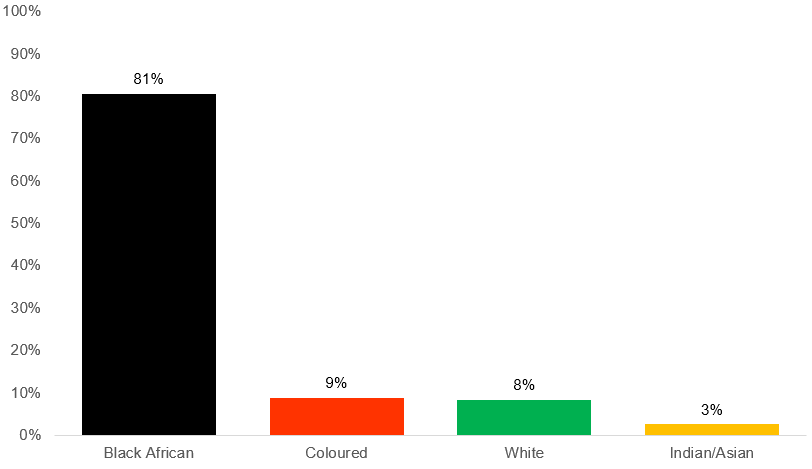
What proportion of South Africans live in an informal dwelling?
Have you ever thought about what proportion of our country live in an informal dwelling such as a shack or backyard? What figure came to mind? StatsSA gives us a very clear answer to this question. Before we take a look at the answer though, this is how StatsSA defines formal and informal dwellings (source):
“[A] Formal dwelling refers to a structure built according to approved plans, i.e. house on a separate stand, flat or apartment, townhouse, room in backyard, rooms or flatlet elsewhere. Contrasted with informal dwelling and traditional dwelling… [An] Informal dwelling is a makeshift structure not erected according to approved architectural plans, for example shacks or shanties in informal settlements or in backyards”
The executive summary of the above-linked report gives us the answer straight away: 14% of South Africans live in an informal settlement (1 in 7), 7% live in traditional dwellings (like a tribal hut) and 78% of South Africans live in a formal dwelling (53% of us outright own these dwellings and 10% of us partially own them; I assume the rest rent):

We’ve just seen that 14% of South Africans live in informal settlements but let’s break this statistic out further to see where South Africans of all walks of life live. As we can see from the dark blue bars in the below chart, most South Africans of all races live in a free-standing brick or concrete house. However, most informal settlement dwellers are black South Africans, followed by coloured South Africans. In addition, almost all traditional dwellers are black. Indian and Asian South Africans are the most likely to live in a flat or apartment while white South Africans are most likely to live in a formal dwelling, although the majority of all South Africans are most likely to live in a formal dwelling.
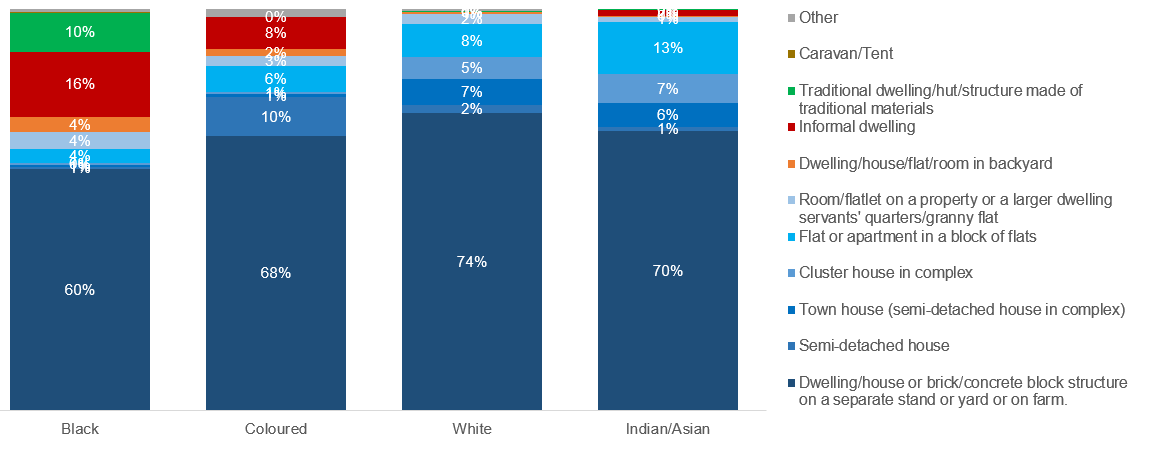
To truly understand the above breakdown though, we need to look at the raw numbers (estimated based on the number of South Africans in 2015 aged 20+ according to Wikipedia). For example, while 8% of coloured South Africans live in informal settlements versus 16% of black South Africans, the absolute number of coloured South Africans in informal settlements is much smaller since they make up so much less of the overall population (compare the size of the red bars in the below chart). Looking at the absolute numbers, we see that the vast majority of informal settlement dwellers are black South Africans. On the flip side of the coin, the vast majority of formal home owners are also black South Africans. As mentioned up front though, this does not take into account the size, value or location of those homes, which would make for some fascinating future research.
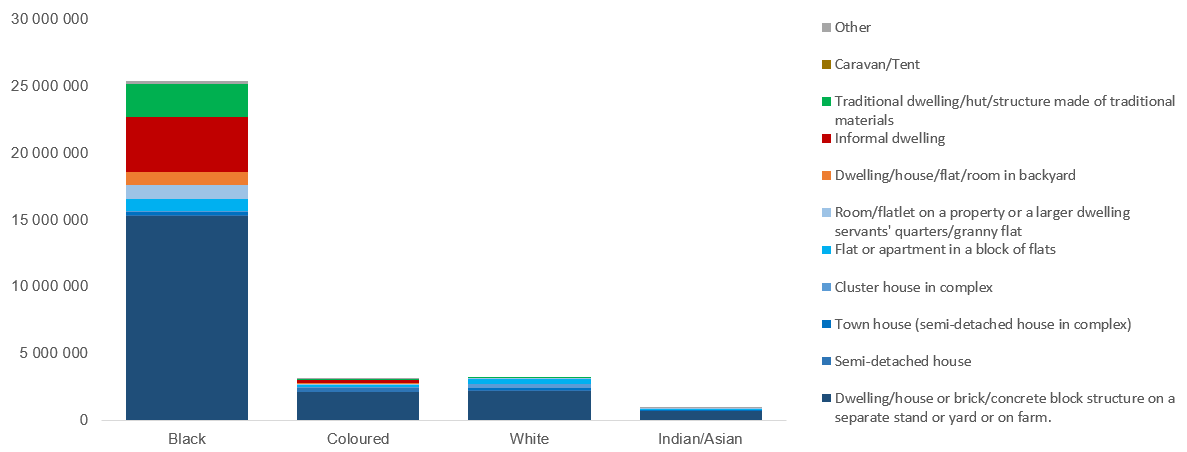
Who owns their homes?
It’s encouraging to see that most South Africans live in a formal house, but do we own our homes or do the banks own them? The below chart breaks down the proportion of each race that outright owns their homes, partially owns their homes (i.e. has a bond or co-owns), rents or occupies rent-free:
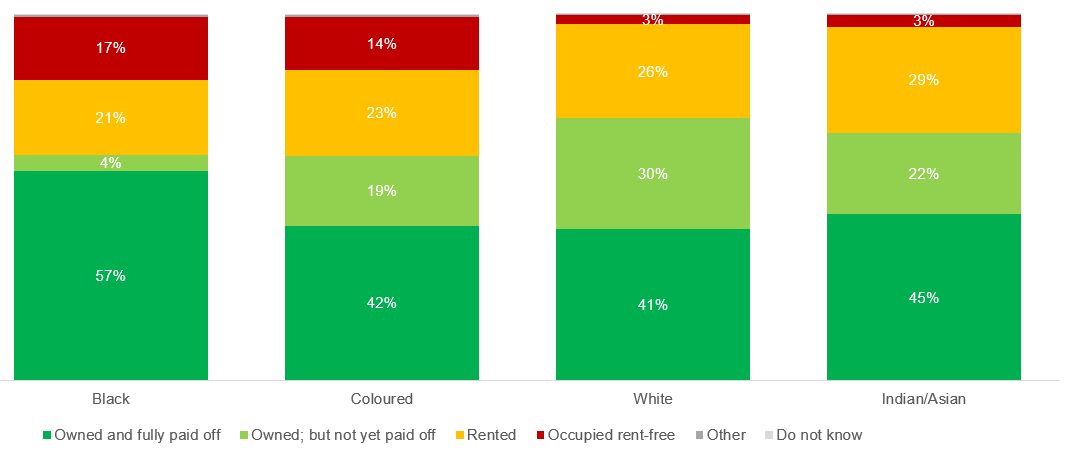
What can we take from the above chart? Well, a few things stand out for me:
- Black South Africans are more likely to own their property than any other race group while white South Africans are least likely to outright own theirs
- White South Africans are most likely to still owe the bank for their houses while very few black South Africans appear to have a bond; perhaps pointing to alternative arrangements that does not rely on financing their homes, likely due to both cultural reasons and a historical lack of access to formal financing
- Indians and Asians are the most likely to rent their property
If we then look at the absolute numbers of South Africans that live in a fully paid-off home, we can see that most outright home owners are black South Africans:

Worryingly though, the below chart shows that the proportion of black homeowners has been decreasing in recent years while the other race groups represent very small, but more stable, proportions of home ownership:
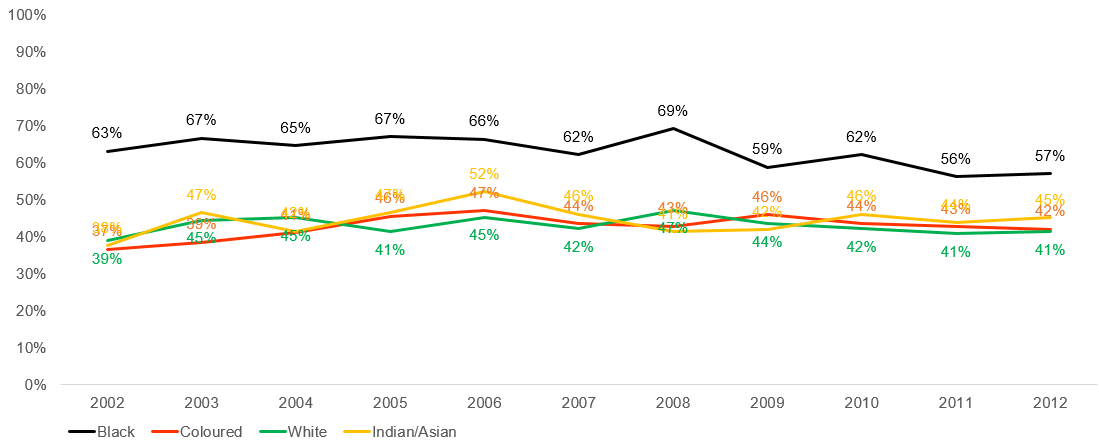
Looking at the trend in the above figures (which admittedly only get us up to 2012 in our data), we can see that:
- Black South Africans are the most likely to own their home but this proportion had been steadily decreasing going into the current decade
- Home ownership peaked for black South Africans in 2008 before declining precipitously, perhaps indicating that many black South Africans who qualified for formal financing before the 2008 crash hit were subsequently disqualified after the crash. This hypothesis is supported by the overall low levels of partial home ownership amongst black South Africans particularly and points to the relatively precarious economic state of many black households.
- Home ownership levels peaked in the mid-2000s for other race groups before slowly declining, likely also in response to the general downward trend in the economy
When we look at these trends in terms of absolute numbers, we see that the vast majority of homes are owned by black South Africans – orders of magnitude more than those owned by all the other race groups combined. As mentioned up front though, what we don’t know from this data is the size, value and location of these homes. For example, many of these could be government-provided homes. According to the Department of Human Settlements (as referenced by Africa Check here and here), 2.9 million houses were built and delivered between 1994 and 2015, which would represent about 20% of the homes owned by black South Africans (assuming that all RDP houses went to black South Africans) shown in this chart :
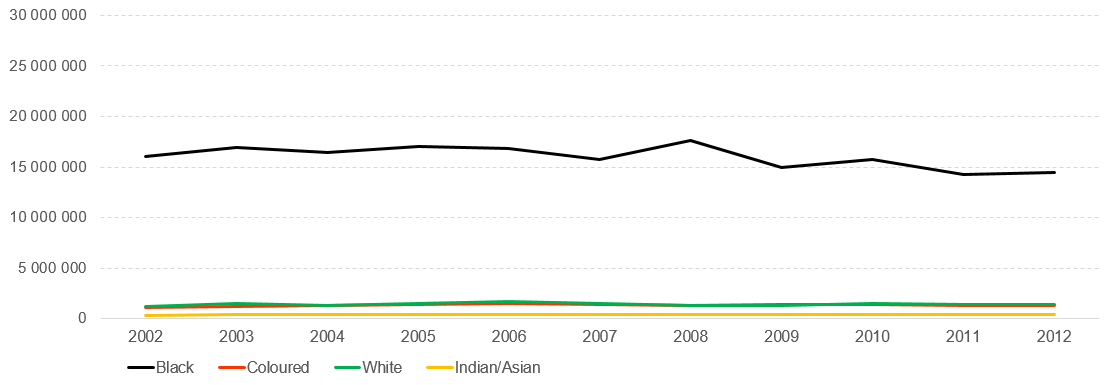
Again, we can see from the above chart that the vast majority of home owners in South Africa are black. However, after peaking in 2008, their numbers had dipped sharply up until when the data stops in 2012.
When we take into account partial home ownership, we see that home ownership jumps to similar levels across all race groups, although the proportions of black and coloured South Africans that own their homes have decreased quite considerably from their peak in 2008 around the time of the global economic crash, again pointing towards the relatively more precarious state of home financing for black and coloured households, perhaps because these groups do not have had the same economic buffers (such as generational wealth) in place to protect them when the market turns?
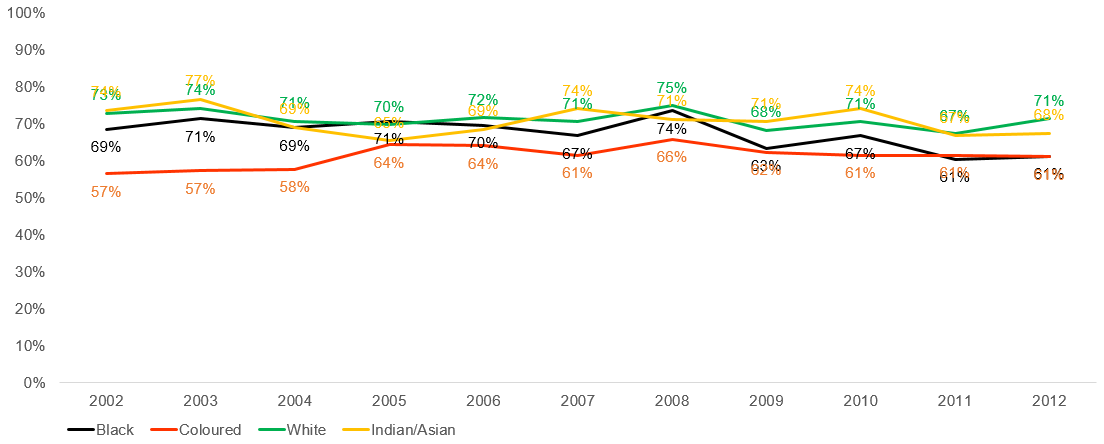
And here are the absolute numbers:
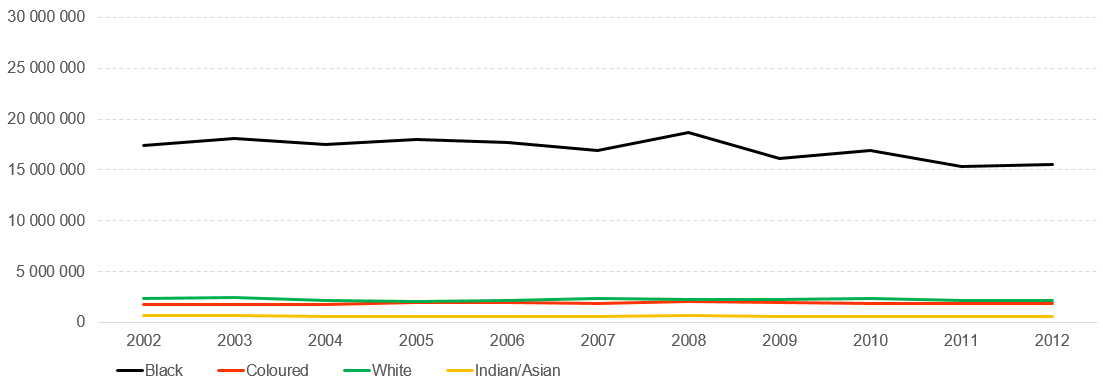
I personally found this data very illuminating. For one thing, I thought that more South Africans live in informal dwellings than the data bears out. This is not to trivialise the issue though since another notable trend in this data is the stubborn persistency of the proportion of South Africans that remain living in an informal dwelling. While we see movement and trends in other dwelling types across racial groups, 1 in 7 (mostly black) South Africans have continued to live in an informal dwelling over the past couple of decades. This is not to say that is it necessarily the same people (although I am sure this is the case for many) – there might still be some upward mobility at an individual level. Part of this might be due to a failure in the formal housing market being able to keep up with our population growth despite the government having delivered nearly three million houses since 1994, forcing new entrants into informal dwellings.
Another interesting trend for me was the high level of black South Africans that do own their own homes. I’d love to see more data on the type of dwellings that black South Africans own but StatsSA’s definition of such dwelling is quite clear: they are proper, planned, real homes.
Despite the high level of home ownership amongst black South Africans, another trend is obvious: black South Africans do not, or are not able to, leverage home financing (such as bonds) nearly to the extent that other race groups do. And, amongst those that do leverage home financing, their situation is precarious as black ownership levels drop the most in times of economic pressure. This shows that many do not have the economic buffers necessary to maintain financing in times of economic stress. Without that buffer, and without having had historical access to such financing, why would a culture of leveraging finance exist? On the other hand, white South Africans are the least likely to outright own their homes but we have also grown up with, see the value in, and, for many of us, have the necessary economic buffers to take on such financial burdens and weather them in times of economic pressure.
What do you think? Do these findings surprise you or reinforce what you already believe?
[Update]
I received a great comment from Ben Cousins of PLAAS in the comments section below clarifying one of the main disconnects: how can so many black South Africans live in a house outside of the formal financing system? Ben’s research clarifies this:
“[The article] misses a key dimension: the meaning of ‘ownership’. In practice this is more complicated than first appears. Do people in communal areas, around a third of the population, ‘own’ their homes? Yes, and no – most do not have title deeds to those homes, and derive their security of tenure from social relations and recognised membership of a group. In addition, many RDP houses have not yet had titles to them issued, and many have been transacted without formal transfer.
In our newly published book. ‘Untitled: Securing land tenure in urban and rural South Africa’ (ed. Hornby, Kingwill, Royston and Cousins, UKZN Press 2017), we estimate is that in 2011 around 60% of South Africans held land or dwellings outside the formal system:
‘1.5 million people lived in RDP houses with inaccurate or outdated titles, in most cases due to transfers outside of the formal system. Another 5 million lived in RDP houses where no titles had yet been issued due to systemic inefficiencies. Along with 1.9 million people in backyard shack, 2 million on farms belonging to others, and 17 million in communal areas, this means that in that year around 30 million people, nearly 60% of all South Africans, lived on land or in dwellings held outside of the cadastral system.’”
[Update]
Please note that some of the charts showing absolute numbers had the figures for white and Indian/Asian South Africans swapped around. This has been corrected. Thanks to those readers who pointed it out.]
[Update]
A reader points towards this report by the Children’s Institute at UCT on child access to housing. Here’s the breakdown of children living in various types of dwelling by province:
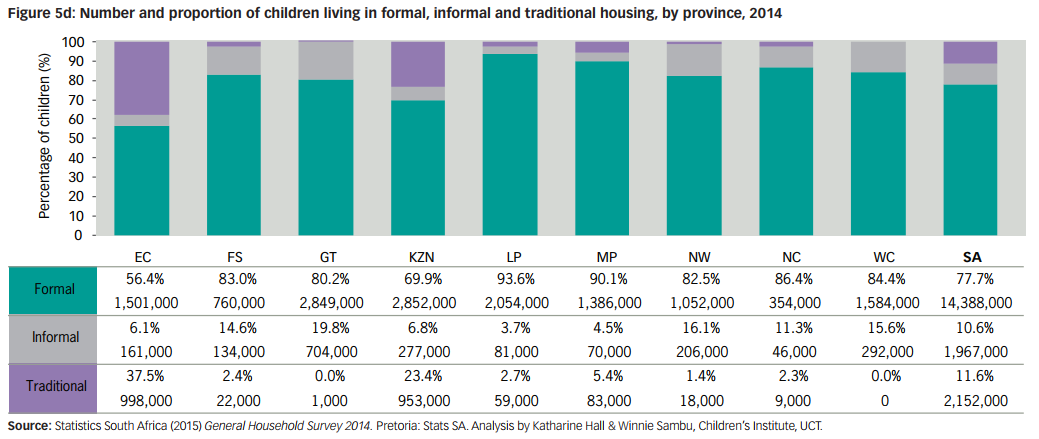
[Update]
See the 2016 General Household Survey results here in the “housing” section.

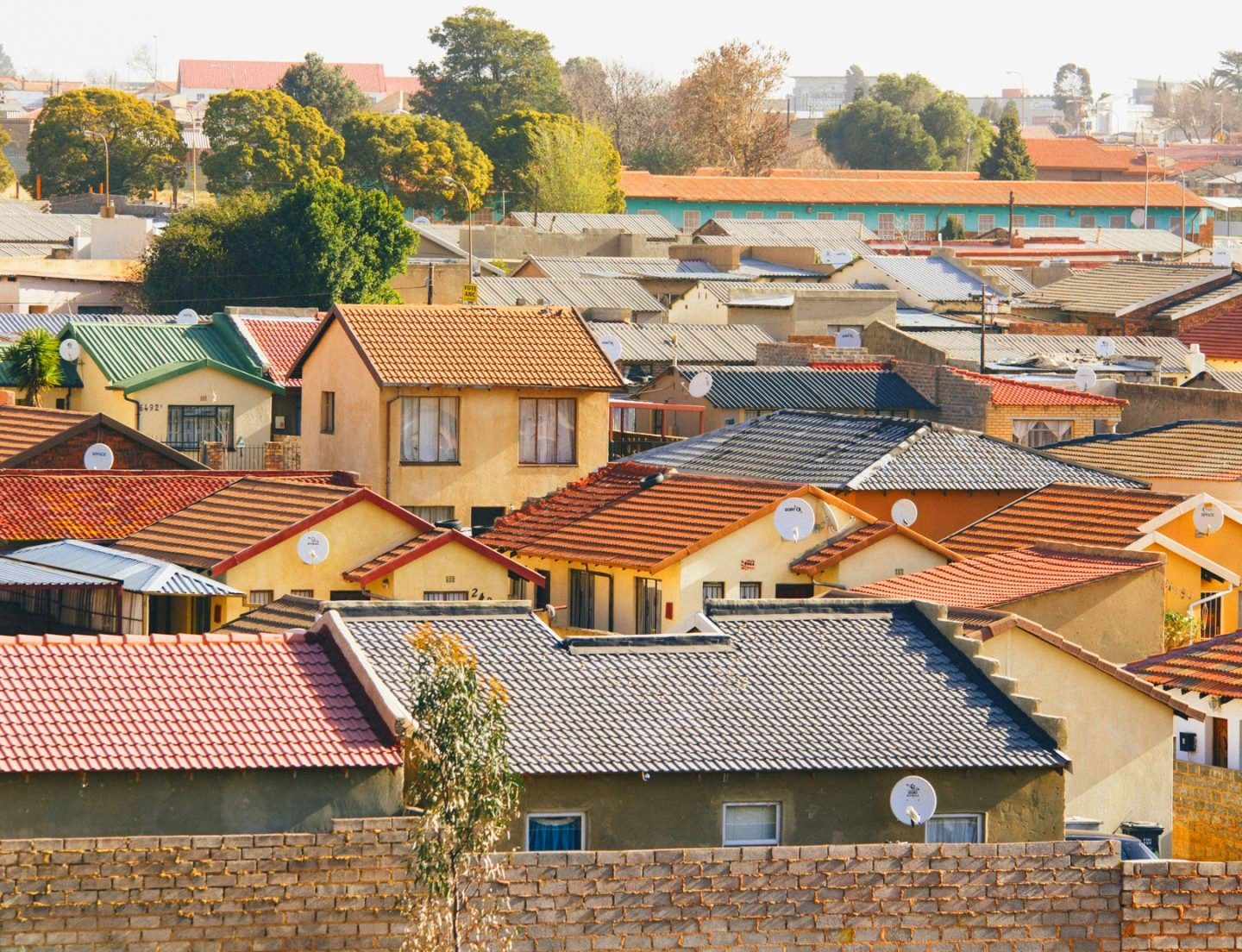



Interesting, but misses a key dimension: the meaning of ‘ownership’. In practice this is more complicated than first appears. Do people in communal areas, around a third of the population, ‘own’ their homes? Yes, and no – most do not have title deeds to those homes, an derive their security of tenure from social relations and recognised membership of a group. In addition, many RDP houses have not yet had titles to them issued, and many have been transacted without formal transfer.
In our newly published book. ‘Untitled: Securing land tenure in urban and rural South Africa’ (ed. Hornby, Kingwill, Royston and Cousins, UKZN Press 2017), we estimate is that in 2011 around 60% of South Africans held land or dwellings outside the formal system:
‘1.5 million people lived in RDP houses with inaccurate or outdated titles, in most cases due to transfers outside of the formal system. Another 5 million lived in RDP houses where no titles had yet been issued due to systemic inefficiencies. Along with 1.9 million people in backyard shack, 2 million on farms belonging to others, and 17 million in communal areas, this means that in that year around 30 million people, nearly 60% of all South Africans, lived on land or in dwellings held outside of the cadastral system.’
What a fantastic clarification of how the system works. Thanks a lot Ben! I’ll add your comments to the article. You’ve solved some of the main disconnects for me: how can so many black South Africans live in a formal structure outside of the formal system? And, where are these houses?
I think the author might have accidentally swapped ‘Indian’ and ‘White” ethnic groups in some of the graphs. For example in the 4th graph “The estimated number of adult South Africans within each race group that lived in each type of dwelling in 2014” the population bar for whites seems to indicate that they around one million of them whilst the population bar for Indians indicates that there are around four million Indians. This error is repeated in a number of other graphs. It is common knowledge that in fact these demographics are in fact swapped with a White population of around 4 million and and an Indian population of around one million. I would encourage the author to review their data and check for errors.
Thanks – I’ll take a look.
Thanks for spotting this. I’ve updated the White and Indian/Asian labels/numbers in several of the charts.
A major discrepancy is the stats on ownership within ethnic groups. Surely the majority of whites (4.5mil) own their own home.Probably close to 80%?Or am I missing something?
Depends what you mean by “own”. The stats show that white South Africans are the most likely to ‘partially own’ their house i.e. have a bond or some kind of financing behind their home.
Pingback: Cyril, please let us smoke, drink; it’s better for SA health than abstinence – academics - Latest News about EB5 Visa
Pingback: South Africa’s COVID-19 lockdown: cigarettes and outdoor exercise could ease the tension – Limpopo Business Online
Pingback: This Travel Elephant? South Africas COVID-19 lockdown: cigarettes and outdoor exercise could ease the tension - The Citizen